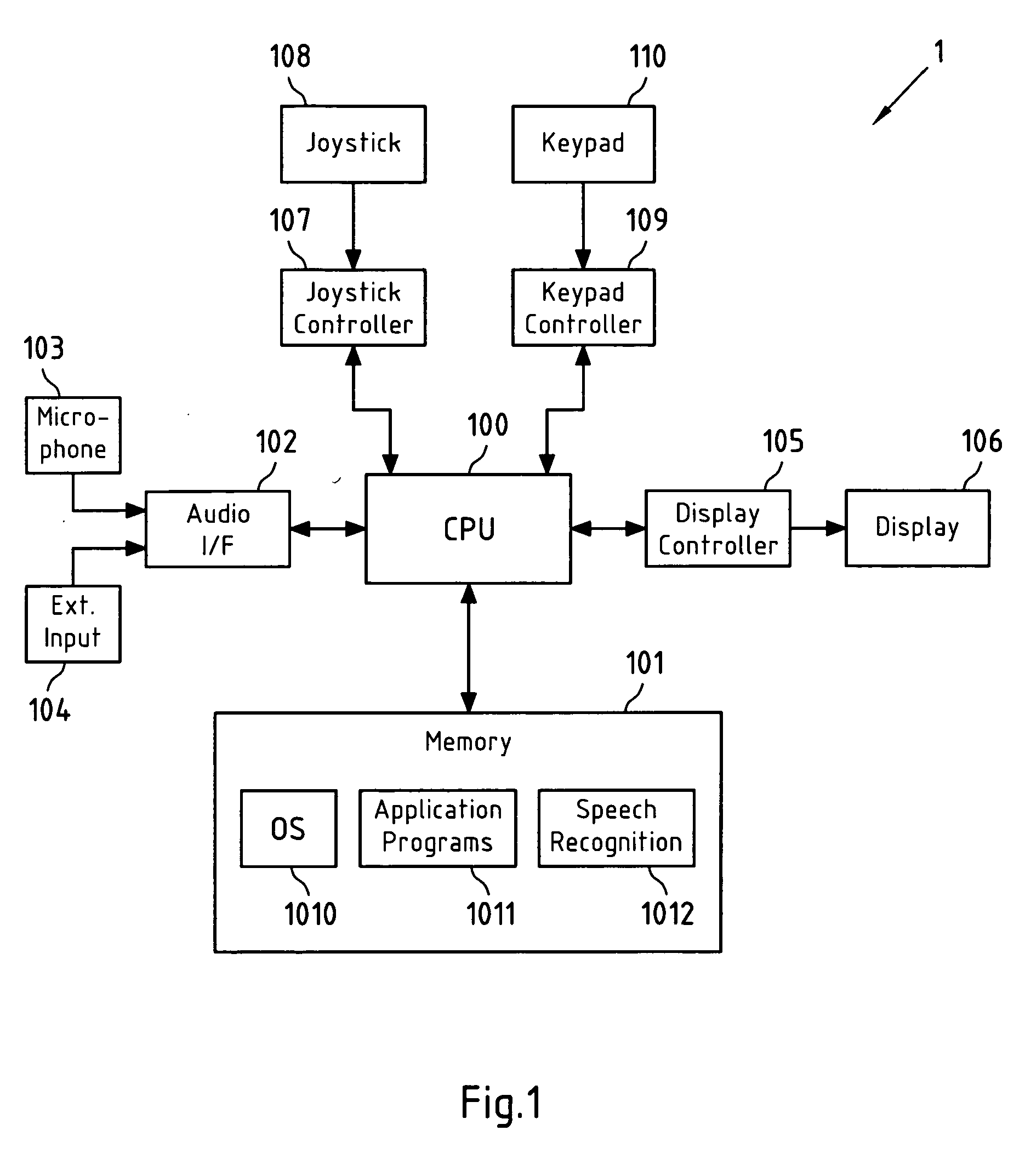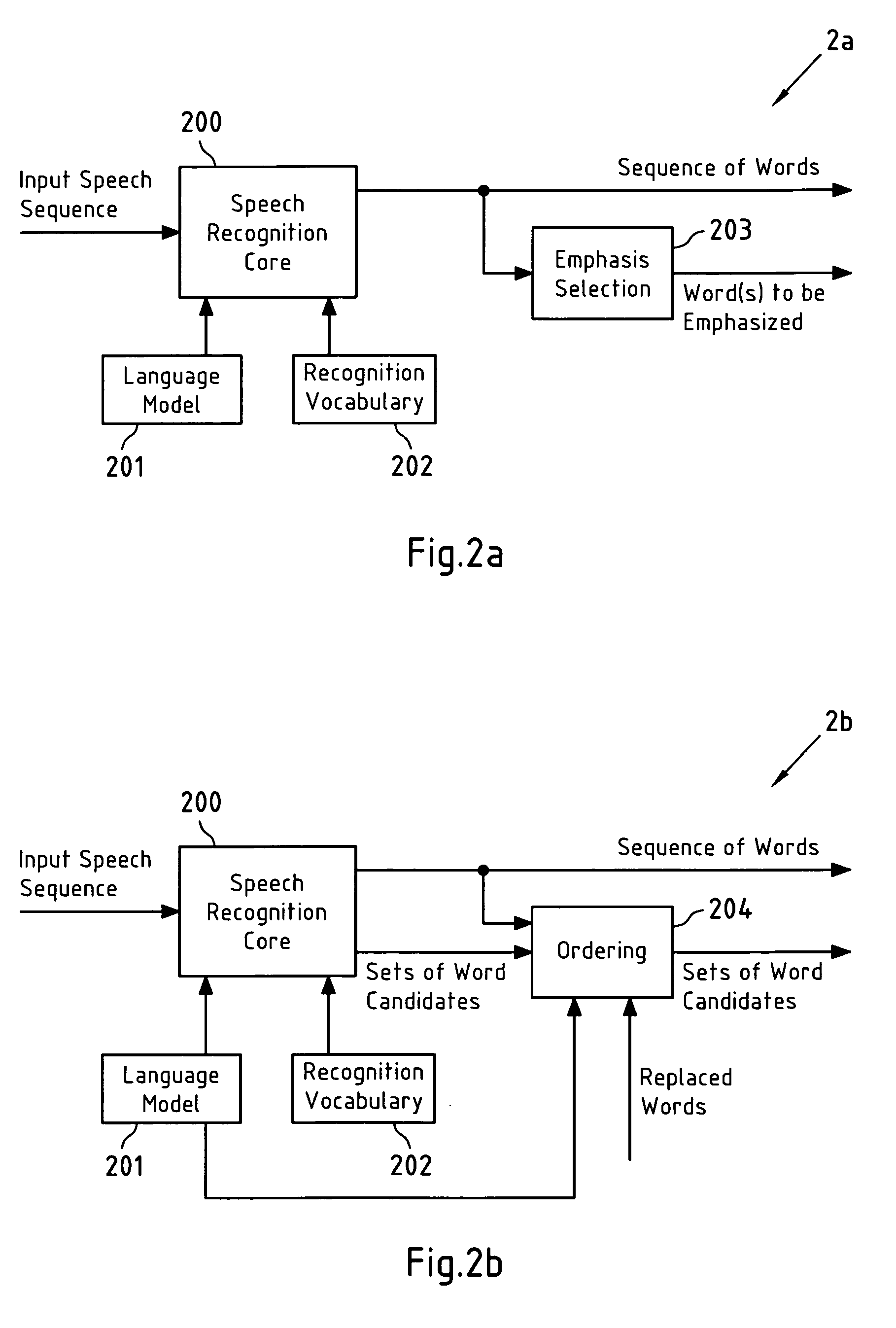[0012] In said presentation of said sequence of words, at least one word of said sequence of words is emphasized in dependence on its recognition
confidence value. For instance, words in said sequence of words which are associated with a particularly low recognition
confidence value (and a correspondingly
high potential error probability) may be emphasized to assist a user in finding errors more quickly or to facilitate their selection for error correction. In contrast to prior art error correction techniques, thus a faster and more efficient error correction can be achieved. Therein, the way of emphasizing depends on the way said sequence of words is presented. For instance, if said sequence of words is displayed on a display, said emphasizing may be performed by changing an appearance of said at least one word that is to be emphasized, for instance by highlighting said at least one word or changing its
font, color or style.
[0014] In an embodiment of the method according to the first aspect of the present invention, said at least one emphasized word is associated with the lowest recognition confidence value of all words in said sequence of words. Said user's attention is then drawn to that word in said sequence of words that has the highest probability of erroneous recognition. The user may then check said word for
correctness and, if said word is found to be incorrect, take action to correct said word. By emphasizing only one single word, an overflowing of the user with information may be avoided when presenting said sequence of words.
[0023] To allow a user to proofread the result of speech recognition, said sequence of words obtained from said speech recognition is presented to said user. Said user then may select at least one word from said sequence of words, if he considers said at least one selected word to be erroneously recognized. In response to said selection, said at least one selected word is replaced by a word candidate from the set of word candidates that is associated with said at least one selected word. Said replacement may be performed automatically or based on user interaction. According to the second aspect of the present invention, and in contrast to prior art error correction techniques, the word candidates in at least said set of word candidates that is related to said at least one selected word are ordered according to an ordering criterion that is related to a likelihood of said word candidates to correctly replace said at least one selected word. This may significantly speed up the selection of word candidates from said set of word candidates. For instance, if said word candidates are ordered with decreasing likelihood to correctly replace said at least one selected word, and if said set of word candidates is presented to said user in the form of a
list (for instance as a scroll-down
list), said user may only have to consider the first entries in the
list until he finds the correct replacement for said at least one selected word. Furthermore, if said user has to move a selector through said list to select the word candidate that shall replace said at least one selected word, also the number of required selector movement steps can be minimized, which makes error correction fast and more efficient. Said ordering of said word candidates in said set of word candidates may for instance be performed only for said set of word candidates that is associated with said at least one selected word, for instance after said selection of said at least one word. This may save some computational complexity required for sorting. Alternatively, said ordering of said word candidates may be performed for all sets of word candidates, for instance during or after speech recognition. Then sorting does not have to be performed after said selection of said at least one word for correction, which may speed up the actual error correction process.
[0029] Said set of word candidates may for instance be presented to the user in a list (e.g. a scroll-down list), and said stepping may for instance be performed by a
joystick, or by arrow keys of a keyboard, wherein each movement of said
joystick (e.g.
scrolling by one entry of said list) or each
stroke on the arrow keys moves a selector forward or backward by one entire word candidate. Apparently, ordering said word candidates, for instance with decreasing probability to correctly replace said at least one selected word, according to the second aspect of the present invention then contributes to reducing the number of steps required in said selecting of said replacing word candidate, as the word candidates that most probably replace said at least one selected word are arranged at the beginning of said list, where also the selector may be initially positioned.
[0031] Therein, said ordering criterion may be solely based on said
language model, which may for instance be a bi-
gram language model, or may be based on further information, such as for instance a recognition confidence of word candidates, as well. When a selected word is replaced by a word candidate from the set of word candidates that is associated with said selected word, the ordering of a set of word candidates associated with a previous word and / or a next word in said sequence of words is updated according to said ordering criterion. As the order of said word candidates in said sets of word candidates associated with said previous and next words depends on said selected and replaced word due to the dependence of said ordering criterion on said
language model (e.g. a bi-
gram language model), updating said sets of word candidates improves the quality of the order in said sets of word candidates and thus contributes to make the error correction according to the present invention faster and more efficient. A case that the order of word candidates in only one set of word candidates requires updating may occur if said sequence of words only comprises two words, one of which is selected and replaced. Furthermore, when assuming that words are selected by a user for correction one after the other, for instance starting from the beginning of said sequence of words, it may be sufficient to update only the order of word candidates of sets of word candidates that are associated with words that are right neighbors of selected and replaced words. This may significantly reduce sorting overhead.
[0039] Thus if an initial speech recognition, which is based on said input speech sequence and a specific recognition vocabulary (representing the set of words that speech recognition takes into account as possible results of speech recognition), leads to an incorrect recognition of said at least one selected word, error correction is performed by repeating speech recognition based on a new
speech input sequence that contains only said spoken representation of said correct version of said at least one selected word and based on a restricted recognition vocabulary, which only comprises the word candidates from said set of word candidates that is associated with said at least one selected word. This may be beneficial in cases when there are significant acoustical differences between said word candidates and only insignificant differences between said word candidates from a language model point of view. In contrast to the large recognition vocabularies typically used in prior art error correction approaches, said reduced recognition vocabulary makes speech recognition according to the third aspect of the present invention less complex, and, correspondingly, also faster and more reliable.
 Login to View More
Login to View More  Login to View More
Login to View More 


